Ready to experience the world’s chilliest and most remote continent? Visiting Antarctica is an incredibly invigorating experience – whether you’re a young adventurer or a senior traveler. From stunning landscapes, abundant wildlife, and unique cultural experiences, there is something for everyone as you explore this remarkable frozen wilderness. This blog post will provide all the necessary information you need to know to make your experience visiting Antarctica as a senior enjoyably and safely.
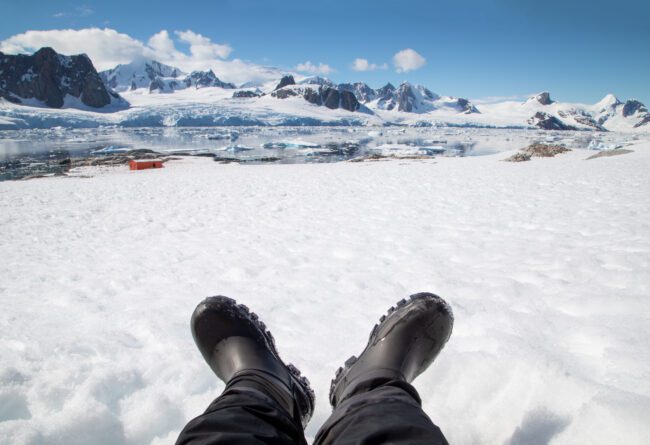

Antarctica is an isolated continent, and due to the extreme conditions, it is usually only accessible during the Antarctic summer months of November through March.
Visiting Antarctica is truly an expedition and is very different temperature-wise when compared to a tropical cruise! We advise guests to prepare for a range of temperatures from -30 to 10 degrees Celsius (-22 to 50 Fahrenheit).
When visiting Antarctica as a senior, you can expect an adventure of a lifetime! Visiting this remote and icy continent is an opportunity to explore some of the world’s most rarely seen landscapes.
Senior travelers should know that visiting Antarctica requires significant physical and mental preparation. Visiting will require extended periods on a cruise ship, including potentially rough seas. Physical requirements may include extensive walking, and traversing potentially slippery surfaces.
It is important to ensure that you have the necessary vaccinations before visiting Antarctica and to consult a physician if there are any medical concerns. Some ships require medical clearance for passengers over 70 years of age due to the strenuous nature of some activities, so it is important to check with the cruise provider beforehand. Please contact our team for more information as each cruise operator we partner with may have different regulations and requirements.
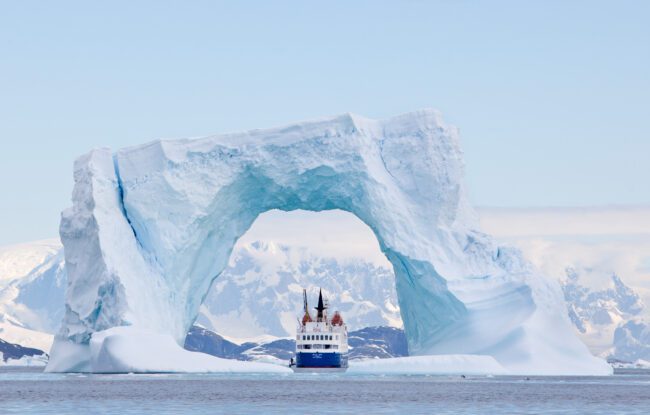

Seniors looking for a once-in-a-lifetime adventure will find it in visiting Antarctica. It is the only continent on Earth that remains largely untouched by humans and is full of amazing sights and experiences.
Visiting Antarctica allows seniors to explore an environment unlike any other planet – from icebergs and glaciers to penguins, seals, and whales. The most difficult part of the journey for most passengers is the crossing of the Drake Passage during the first and last 2 days of the voyage. If you are worried about motion sickness you may be more comfortable flying to and from the continent! You can choose from several flight experiences and may choose to fly to the continent and then board a ship upon landing. Some travelers choose to fly to the continent, sail around the region for a few days, and then fly back. Some also choose to fly to the continent, sail around the region, and then sail back as well! Check out our Flying to Antarctica page for more information, or contact our team!
Visiting Antarctica as a senior requires some careful planning. Make sure you know how long you will be visiting, what kind of activities you want to do, and what you need to bring. It would help if you also considered the weather conditions during the time frame you are considering for your cruise! We have a month-by-month guide for planning which describes weather, likely animal spottings, and activities available.
Finally, we recommend considering what you would like to budget for your Antarctic cruise vacation. Visiting Antarctica can be expensive due to the logistics involved in getting there and outfitting for such a remote location. However, there is quite a price-range associated with different types of cruise experiences based on activities, destinations, the time of year, when you book, the type of cruise ship you want to be on, and if you book during a sale. We work with multiple different cruise lines to shop the best deals for our clients, so please contact our team if you would like assistance in finding the best deal on your cruise!
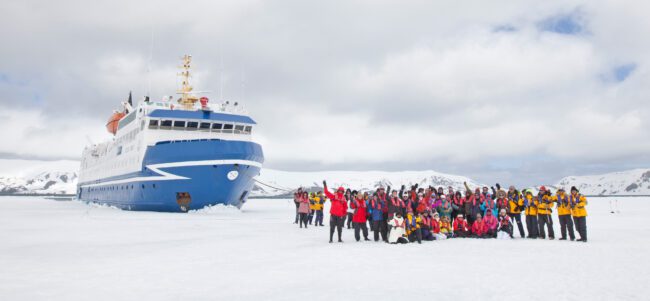

An Antarctic expedition can range from a few days to several months, depending on the activities you plan to do. Visiting Antarctica as a senior is best done with an organized tour, which typically lasts between two and six weeks. During this time, you may choose from a variety of experiences, including snowshoeing, kayaking, camping, and other activities.
Depending on the length of your tour, you may have time to visit multiple locations or participate in additional programs such as whale watching or seeing flora and fauna unique to Antarctica. Since conditions can be harsh and unpredictable, it is important to plan accordingly when visiting Antarctica.
You should ensure that you are physically and mentally prepared, that you pack appropriately for the cold environment, and that you have all the necessary supplies. Planning helps ensure a safe and enjoyable trip.


A visit to Antarctica is more than just a cruise. It’s an expedition. Visiting Antarctica as a senior is far different than taking a traditional cruise. While you can expect the same degree of comfort, food, and entertainment aboard an expedition vessel as you would on a cruise ship, the main difference lies in what’s available. Visiting Antarctica requires expedition planning and preparation not only to ensure the safety of the passengers but also to experience the region’s beauty and wildlife firsthand.
An expedition to Antarctica encompasses more than just a leisurely visit in which you can explore glaciers, take photographs, and observe Antarctic wildlife in their natural habitat. It also includes educational lectures and activities, such as kayaking or camping on the ice, to provide passengers with a hands-on experience. Visiting Antarctica as a senior may also include visits to science research stations and other places of interest.
The safety of the crew and passengers is taken very seriously when visiting Antarctica. An experienced guide will always be present to ensure that everyone takes the necessary precautions and answers any questions or concerns.
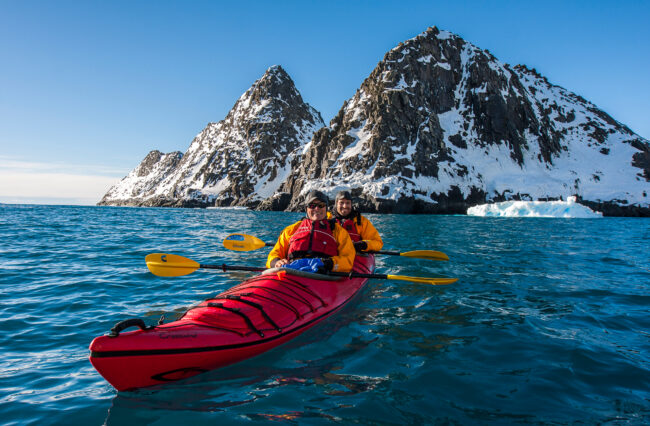

Visiting Antarctica can be an exciting and unique experience. There are many activities you can engage in while in the polar regions. From seeing wildlife to trekking across glaciers – there are plenty of opportunities to explore and experience all the continent has to offer.
If you’re looking for adventure, why not cruise around the Antarctic Peninsula? You’ll experience some of the most breathtaking scenery on earth, including towering icebergs, snow-covered mountains, and pristine glaciers. Wildlife encounters are also possible – you may spot penguins, whales, seals, and other creatures in their natural habitat.
Exploring hikes can also be an exciting way to explore the continent – traverse snow-covered terrains and glaciers, taking in magnificent views along the way. Visiting scientific research stations can also be an interesting option – you’ll have the chance to interact with researchers and learn more about the region’s unique wildlife.
No matter what activities you choose while visiting Antarctica, your experience will surely be memorable. Visiting Antarctica as a senior is an incredible opportunity – you will get to explore the continent and gain valuable knowledge and understanding of its delicate ecosystems.
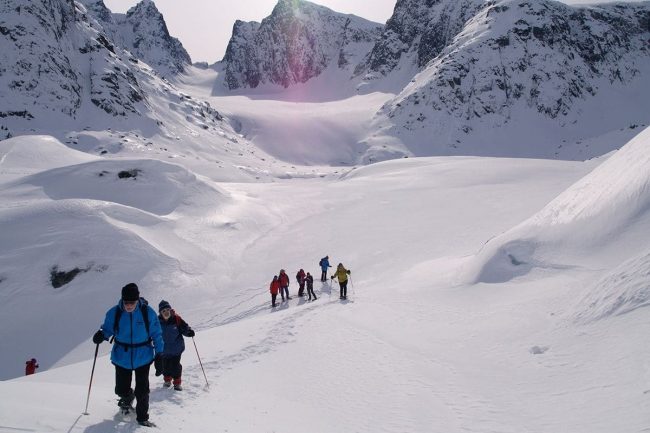

A trip to this remote continent can be an amazing experience for everyone. When on the cruise ship you will have the opportunity to see marine life including seals and many species of whales. You will also see many incredibly unique icebergs and ice formations!
Once off the ship, passengers may cruise the waters in zodiac boats to see the ice formations up close, as well as other landscapes or areas of interest spotted by your guide. Ashore, you may explore on foot with hikes, snowshoe activities, and more! Some cruises offer helicopter flights as well! Make sure to speak with our team if you are interested in helicopter rides, certain ships are built with landing pads to accommodate this activity.
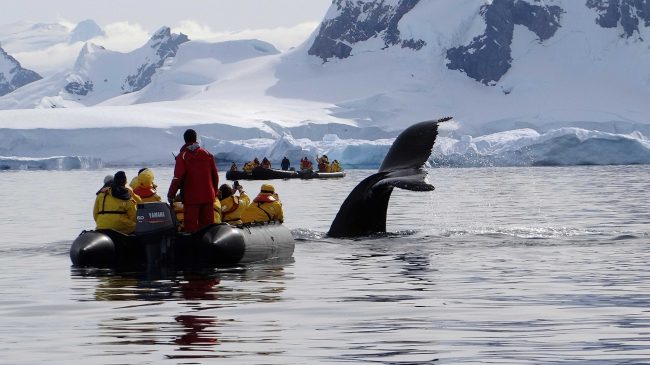

Visiting Antarctica as a senior is an amazing opportunity to explore and discover the wonders of this remote continent. There are a few important things to consider when planning your trip, including the type of ship you’d prefer, what activities you can do while there, and how to stay safe in such harsh conditions.
You’ll need to determine which type of vessel is best suited for your experience. Generally, you may choose from a cruise ship or expedition style ship, and these vessels have specialist navigation and safety equipment that enables safe travel through the icy waters. For specific ship information please speak with our team or take a look at our ships!
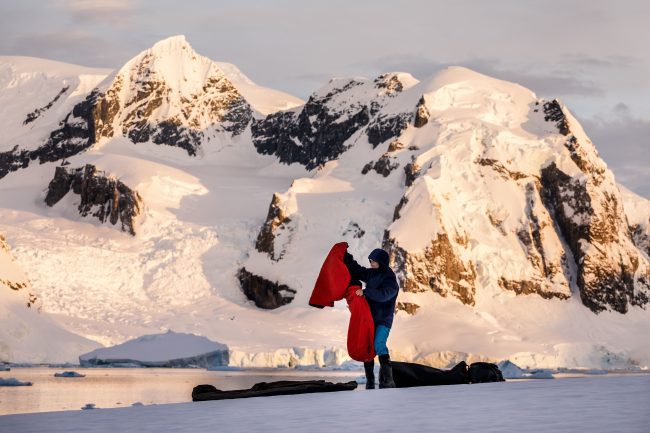

You will find that Antarctica is full of opportunities for adventure and exploration. While planning your cruise, consider the destinations you would like to visit! You can find more information on our Antarctica Destinations page.
When visiting Antarctica, you will find plenty of activities to participate in, from camping to kayaking and even skiing. Visiting Antarctica as a senior also allows memorable experiences such as taking a hot air balloon ride or sightseeing around the famous Ross Ice Shelf.
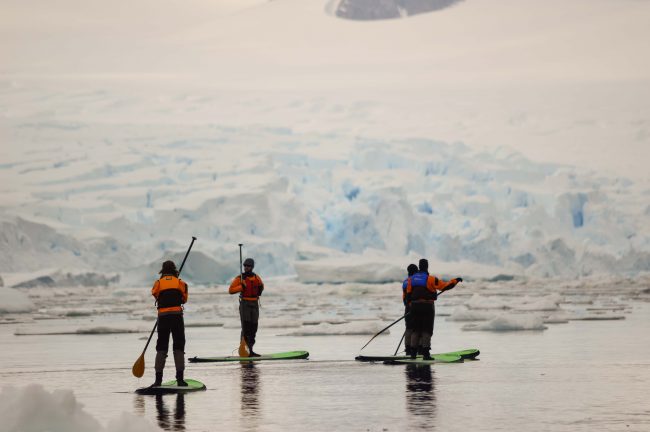

For those who want to explore the beauty of Antarctica, stand-up paddleboarding (SUP) is a great option. With its unique landscape and wildlife, Antarctica makes for an unforgettable experience. SUP lets you get up close and personal with the sights and sounds of one of the world’s most pristine locations.
Make sure to choose a cruise with SUP as an activity option if you would like to experience this on your expedition. Not sure which cruise has this activity? Reach out to our team for assistance with booking the right cruise for you! When your ship arrives near the continent, you will be provided your wetsuit and all the necessary safety equipment – life jackets, helmets, etc. You’ll be provided a board. Once set up, it’s time to get out on the water and explore the Antarctic coastline with your group and guide!
As a senior, taking your time when visiting Antarctica is important. Make sure you don’t overexert yourself during excursions or activities. SUP is a great way to explore the area without exerting too much energy. You can slowly paddle along, taking in all the sights and sounds of the area.
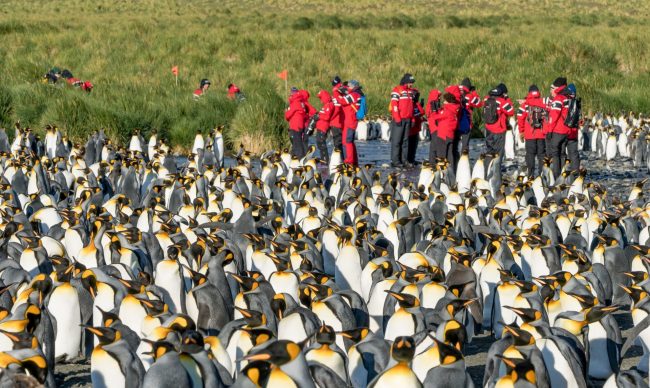

Visiting Antarctica as a senior is an exciting and life-changing experience. It’s important to ensure you’re properly prepared for the journey ahead. Here are some tips on what to bring with you on your trip:
Warm clothing:
You’ll need to pack plenty of warm layers to keep you comfortable in cold temperatures. Make sure to bring waterproof and windproof clothing, a hat, gloves, and boots.
Sunscreen:
Even though you’re surrounded by snow and ice, the sun can be very strong in Antarctica due to its higher elevation. This means you must pack plenty of sun protection, including sunglasses.
Food and drink:
No need to pack food or drinks! Our cruise ships have fully stocked dining halls and there is no shortage of (really good) food or beverages!
Medication:
Pack enough for the entire trip if you’re taking any medication.
Travel documents:
Ensure you have all the necessary documents, like a valid passport, and insurance policy.
For more in-depth information on packing, please see our Preparing For Your Polar Cruise page.
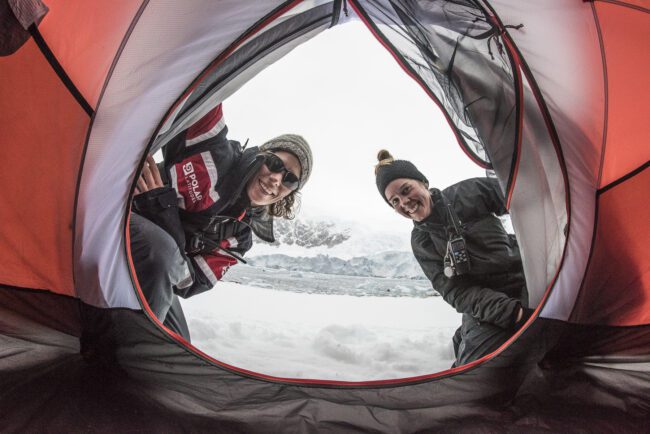

One of the most unique experiences available to seniors is camping on Antarctic voyages. Visiting one of the world’s last great wildernesses is an incredible opportunity, and it’s possible for those willing to brave the elements.
Camping gear and instruction will be provided by your guide, so do not worry, your safety and comfort is of the utmost importance!
Make sure you have the right camera to document your Antarctic expedition! Most phones nowadays have fantastic cameras, but if would like to bring a more serious camera, read our Cameras in Antarctica blog post!
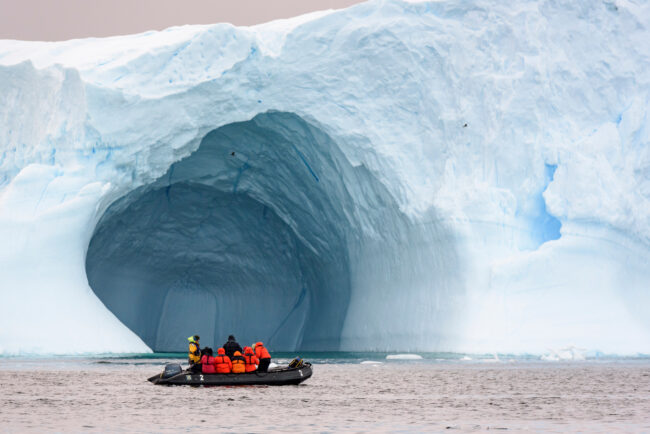

Visiting Antarctica as a senior is generally safe if you take the right precautions! Follow your medical provider’s advice when considering an Antarctic cruise, and make sure to pack for your needs.
No, no special visas are required to visit Antarctica as a senior. However, it is important to check the requirements for your home country before embarking on your trip.
Antarctica is a unique destination that offers many exciting sights. Visiting Antarctica as a senior will allow you to experience the pristine landscape and wildlife, including penguins, seals, whales, and more. You may also have the opportunity to explore icebergs and glaciers.
No, there are no age restrictions to visiting Antarctica as a senior. However, it is important to remember that some trips may not suit seniors with mobility issues. Check with your tour operator to find out if the trip you are interested in suits your upper age limit and physical condition.
Generally, the best months to visit Antarctica as a senior are during the Antarctic summer in November, December, and January. Visiting this time of year allows you to experience warmer temperatures and extended daylight hours.
As a senior, it is important to purchase travel insurance for visits to Antarctica. Travel insurance protects you from medical emergencies, missed flights, and lost or stolen items. Ensure your policy covers activities such as ship cruises, sea kayaking, and skiing.
Antarctica is a bitterly cold destination, with temperatures reaching as low as -90°C (-130 F) in the winter. During the summer months, average temperatures range from 0°C to 7°C (32 F to 45 F). Visiting during the Antarctic spring and summer offers seniors some of the most comfortable conditions.
At Polar Holidays we work with the best luxury and expedition cruise line companies to offer the best service, experience, and price for our customers. We have almost two decades of polar travel experience to both Antarctica and the Arctic. We would love to help you find the perfect cruise for you, as well as answer any questions you may have regarding Antarctic travel.
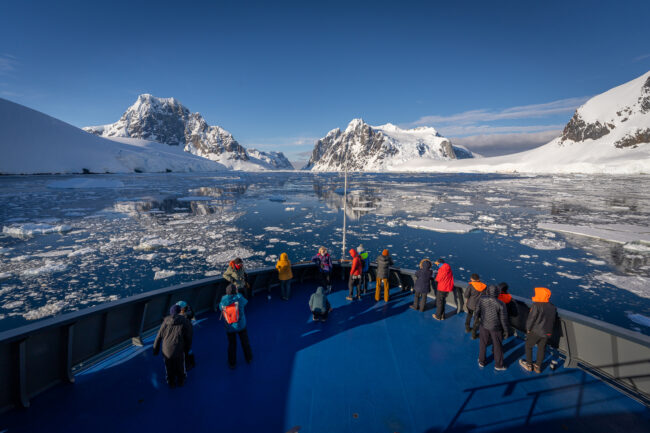

We hope this blog has given you an insight into the possibility of visiting Antarctica as a senior. Antarctica is a world like no other and offers some of the most breathtaking sights that nature has to offer. With its remarkable history and diverse wildlife, there’s something for everyone in this majestic frozen continent.
Whether you’re a seasoned traveler or a first-time visitor, visiting Antarctica as a senior can be an incredibly rewarding experience. So gather your courage and prepare for the journey of a lifetime – Exploring this continent is something few will ever do, so why not make the journey yourself!
What camera should you bring to Antarctica, you ask? If you are passionate about photography, this article is for you! And if you are not as passionate about photography, this is also the article for you. As the anticipation and your packing list is growing, make sure to have the right camera packed to suit your needs! It is essential to pack the camera that will capture Antarctica’s natural beauty. Better yet – bring more than one. Anything can happen, and there are no stores in Antarctica to buy a replacement!
Antarctica has a remarkable and “one of a kind” display of wildlife, landscapes, and history. No matter how many times you travel to Antarctica, each adventure will be the experience of a lifetime. While your eyes are best for capturing memories, bringing a camera to catch everything along the way ensures that you can share your adventure with friends and family when you return! It is important to embrace every second you have in Antarctica, and it is critical to choose a camera that will capture Antarctica’s natural beauty for you to reflect on for a lifetime.
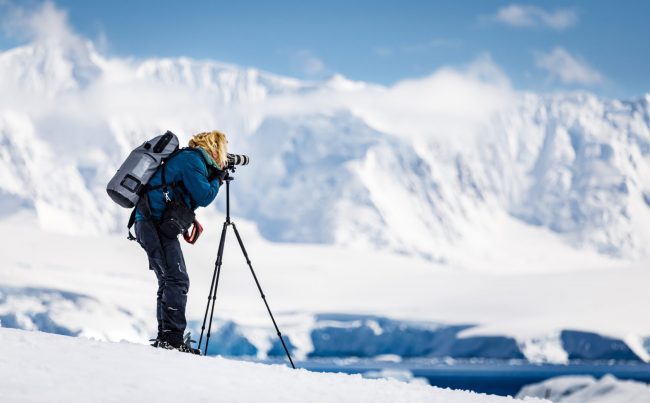

The camera you bring depends on your style. There is not necessarily a “right” or “wrong” choice concerning cameras for photography in Antarctica, but different cameras match different needs. If you want to travel light, bring your phone and use it’s camera. Most smartphones lately are equipped with great technology and some even take RAW images providing greater editing ability after capture. If you are more serious, bring a small point and shoot camera. If you are very passionate about photography, bring a mirrorless camera or DSLR to ensure the highest quality photos.


Camera phones have become better and better every year in their photography quality, so take your phone if nothing else! For those that like film, bringing disposable cameras may make photography fun (just make sure you don’t forget to have them developed once you return home)!
Although camera phones may not suffice for those that are passionate about photography, they still do a great job. Technology has evolved and many phones today have many features that cameras have. For example, cell phones take high-quality images and typically have time lapse, panoramic features, and high resolution video capabilities. Phones have many similar abilities to cameras, sometimes even more that could help with taking photos of Antarctica’s natural beauty. For example, you can adjust focus and you can adjust the brightness of the image before actually taking the picture. If an image comes out too dark or too bright or the white balance is off, you can always use the photo editing software on your phone and quickly change those settings.
Just like with the “regular” cameras in Antarctica, be mindful of salt water and moisture. Always keep your phone in your jacket pocket when there is water, rain or snow. This will help protect your cameras in Antarctica weather. If you use your camera phone a lot, we recommend buying a holder or grip for it. If you do, bring a holder, your hands will thank you, your phone will be a lot easier to hold, and you can activate the shutter from that grip. This will increase the quality of the photos you take!
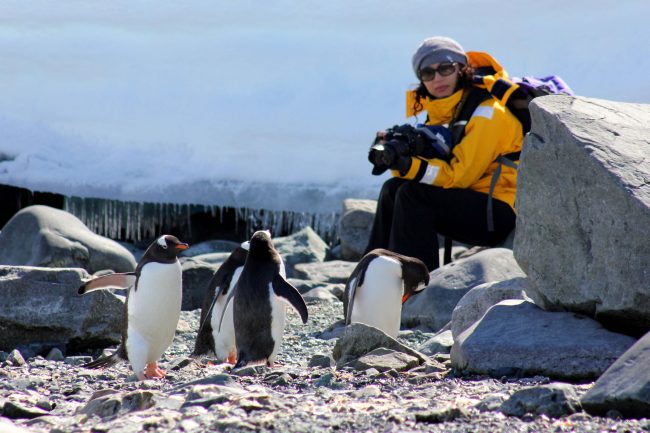

Smaller, portable cameras have made great strides regarding image quality—making it an admirable selection of cameras in Antarctica. A small point and shoot camera that has a zoom lens with a wide angle to a telephoto setting will be an awesome companion for your cruise experience as you capture Antarctica’s scenery and wildlife. If you bring a camera with interchangeable lenses, cover the focal lengths from 20 or 24 millimeters to about 200 or 300 millimeters. Everything else beyond that would likely be too heavy and burden you on your Zodiac boat rides and landings. Today’s cameras have many mega pixels. You can always crop your images a little bit, too.
There are rules surrounding the minimum distance you can approach wildlife – you cannot get too close and disturb the penguins and seals. Hence, reason that a moderate telephoto zoom lens will be useful—it should cover a range of about 50 to 200 or 300 millimeters. Every camera manufacturer has a different set of lenses – most DSLRs have 24 -70 millimeters, as well as 100-400 millimeters or 100-300 millimeter lenses. If you’re bringing what is called a crop camera, you can easily get away with something in the 100 to 200-millimeter range.
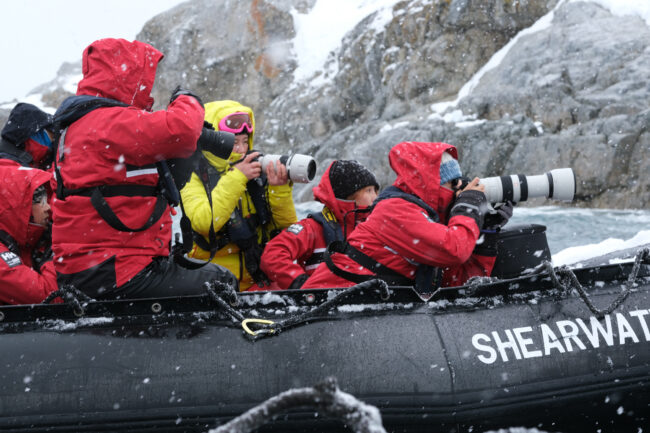


You do not need filters, except for a UV filter to protect the front of your lens from water, and perhaps a polarizing filter—not for the skies! I do suggest bringing it as you may see seals and penguins underwater. A polarizing filter will eliminate or at least reduce the reflections on the water’s surface. It will also protect your lens from spray, rain and snowfall.
The biggest enemy for your cameras in Antarctica will be the salt water. Always be careful when you are on your zodiac rides from the ship to shore. It is important to leave your camera in its bag or cover it with your body. It is vital to bring a protective case for all cameras in Antarctica, as the weather is constantly changing and there may be snow or rain at any point in time. When the cameras are brought back to the ship, leave them in the cases or wrap them in a plastic bag or a towel. The difference between outside and cabin temperatures is often large, and the cameras in Antarctica get condensation on the inside of the lenses. That condensation may take a long time to get rid of. If this happens to your cameras in Antarctica, you will see it as “fog” in the middle of the lens. To fix this issue, you may use the hair dryer in your cabin and blast the lenses with the warm air; forcing the condensation to go away within a few minutes.
For those that are passionate about photography and want to always capture Antarctica’s natural beauty, feel free to complement your experience by taking videos. If you are wanting to take videos with your cameras in Antarctica, be sure to take a small tripod. This does not have to be a multi-pound large tripod that extends to 5 or 6 feet. Rather, a table-top one that is 5 or 6 inches tall will suffice. While exploring, you can usually find a rock or block of ice to set this tripod and your camera on.
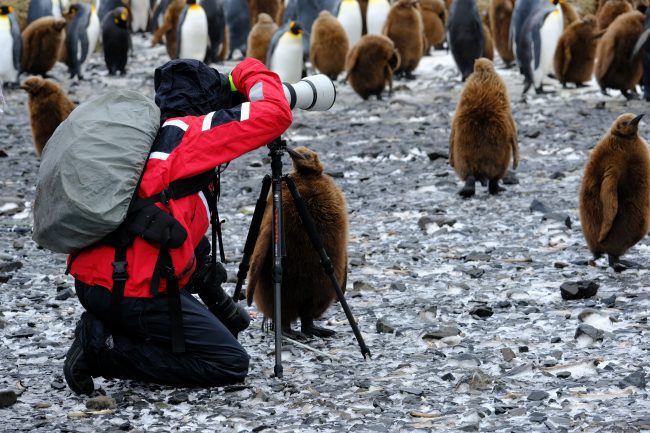

Ensure that you have lots of memory cards and extra batteries for your cameras in Antarctica. Charging batteries will not be an issue: you can always charge your batteries back on the cruise ship. On the other hand, you will not be able to buy memory cards during your cruise for your cameras in Antarctica. A piece of advice is to bring twice as many memory card space you think that you may need. Another alternative is to bring a tablet or a laptop computer to download images. You do not want to be stuck without a camera while trying to appreciate Antarctica’s stunning views.
Overall, a variety of cameras will help with capturing Antarctica’s natural beauty—there is no “right” or “wrong” options. Some key pieces of advice are to bring back-up batteries, bring gear to protect your cameras in Antarctica, and haul extra memory cards—even when you don’t believe it is necessary. If you have any questions please reach out to our team! We’re happy to help with any advisement as our founder is a world-travelled photographer and is passionate about polar photography.
If you’ve ever dreamed of cruising to Antarctica, this article is for you! I’ll be sharing all of my experiences on Antarctica cruises, from what to expect onboard to the exciting excursions available. Whether you’re planning your own Antarctic adventure or simply curious about what it’s like, read on for a firsthand account. Bon voyage!
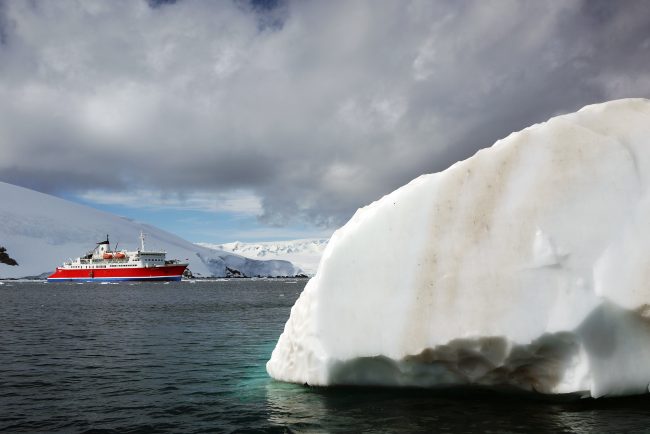

If you’re considering an Antarctica cruise, you might be wondering what the experience is like. Here’s a quick overview of what you can expect on a typical Antarctica cruise.
Most Antarctica cruises depart from either Argentina or Chile, and the journey to the Antarctic Peninsula takes two to three days. During this time, you’ll cross the Drake Passage – one of the most treacherous stretches of water in the world. But don’t worry, your experienced captain and crew will get you safely to your destination.
Once you reach Antarctica, you’ll have the opportunity to explore by small boat, go on hikes, and even camp overnight on the continent. You might also see some of the local wildlife including penguins, seals, and whales!
No matter what you do on your Antarctica cruise, it’s sure to be a once-in-a-lifetime experience. So if you’re an adventure-seeking traveler, this is definitely the vacation for you.
Antarctica is the world’s coldest, windiest, and most isolated continent. It’s also home to some of the planet’s most amazing wildlife – penguins! If you’re thinking of taking an Antarctic cruise, here’s what you can expect.
Most Antarctic cruises depart from Ushuaia in Argentina, the world’s southernmost city. Ushuaia is sometimes referred to as the “end of the world.” The journey across the Drake Passage can be rough, with strong winds and waves. But it’s worth it for the chance to see icebergs, glaciers and wildlife up close.
Once you reach Antarctica, you’ll have the opportunity to go on excursions ashore. Popular activities include hiking, kayaking and visiting research stations. You’ll also have plenty of time to just sit back and enjoy the incredible scenery.
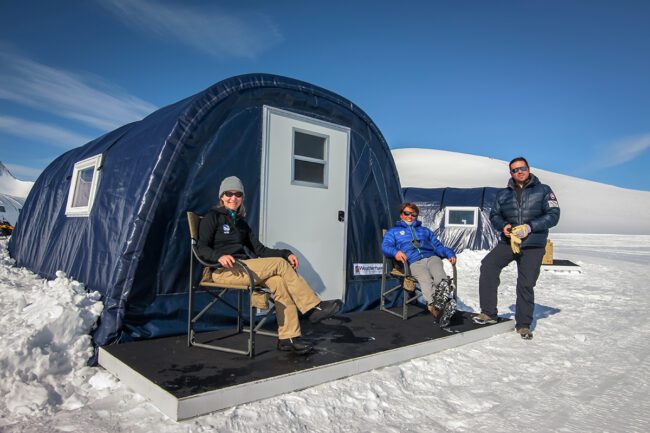

Choosing the right cruise can be a daunting task. There are so many options and variables to consider, from destination and budget to ship size and amenities. But don’t worry, we are here to help!
Decide on your must-haves: What are your deal-breakers? Be sure to choose a cruise that has everything you’re looking for, whether it’s non-stop entertainment or ample opportunities to relax.
Consider your travel companions: are you bringing the whole family? Just a few friends? Make sure to pick a cruise that will accommodate your needs and provide plenty of activities for everyone.
Choose your perfect destination: there are cruise options to nearly every corner of the globe. Do you want to explore antarctica a new culture? See the sights of a major city? Or just relax on a beautiful beach? Pick a destination that’s right for you and get ready to set sail!



When you’re planning a trip, it’s important to make sure you have everything you need. This can be a daunting task, especially if you’re traveling to a new place. To help you out, we’ve put together a list of essential items to pack for your next trip.
This is essential for carrying all your things, and it should be comfortable to wear for long periods of time.
This is a great way to capture memories of your trip.
Make sure to pack clothes that are appropriate for the weather and the activities you’ll be doing.
Again, make sure to pack shoes that are comfortable and suitable for the activities you have planned.
Don’t forget to pack your toothbrush, toothpaste, and any other toiletries you need.
It’s always a good idea to have snacks on hand, in case you get hungry.
These are just a few of the things you should pack for your next trip. With these items, you’ll be prepared for anything that comes your way.
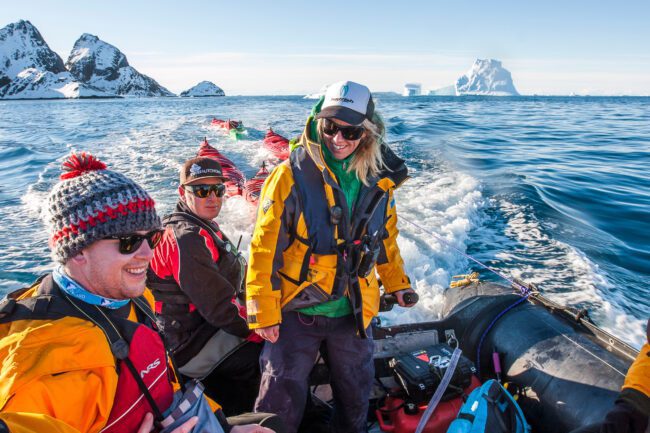

The average Antarctica cruise cost is about $8,000 USD per person. This includes the cost of the cruise, airfare, and other necessary expenses. For a more luxurious experience, some people spend upwards of $20,000 USD per person.
Most Antarctica cruises depart from Ushuaia, Argentina. From there, you will take a flight to Antarctica which is about four hours long. The average cost of a flight from Ushuaia to Antarctica is $12,000 USD.
Once you are in Antarctica, you will spend most of your time on the ship. The average cost of an Antarctica cruise is $120 USD per person per day. This includes all meals and activities onboard the ship.
If you want to add some extra activities, such as kayaking or hiking, you can expect to pay an additional $50-$100 USD per activity.
Overall, an Antarctica cruise is a once in a lifetime experience that comes at a high cost. However, many people believe that it is worth the money because of the incredible scenery and wildlife that you will see.
Having heard the horror stories about just how cold it gets in Antarctica, you’re probably picturing a frozen wasteland where the only thing to do is bundle up and stay indoors. But the truth is, Antarctica is actually an enjoyable place to explore as long as you have the right layers!
Travelers will always enjoy memorable experiences on their Antarctic cruise. But, frankly, which month you visit during the year makes a big difference in what you see and do.
December to February is high season for Antarctica cruises, and for good reason. This is when you’re most likely to have sunny weather and calm seas. It’s also the best time to see penguin chicks, as they hatch in November and December.
May to August is the shoulder season, when you’ll find lower prices and smaller crowds. This is also a good time to go if you’re interested in seeing whales, as they migrate to the area in search of food.
October and November is considered the off-season, as this is when Antarctica is in the midst of its winter. But that doesn’t mean there’s nothing to see and do. In fact, this is a great time to go if you’re hoping to catch a glimpse of the Aurora Australis, also known as the Southern Lights.
Those who have traveled to the Arctic might be familiar with the concept of the Arctic Circle. But did you know there’s also an Antarctic Circle?
Most Antarctica cruises don’t actually sail as far south as the Antarctic Circle, but if you’re hoping to make the crossing, you can book a specific Antarctic expedition cruise to this region. These trips typically last at least three weeks, and they take you to some of the most remote and untouched parts of Antarctica.
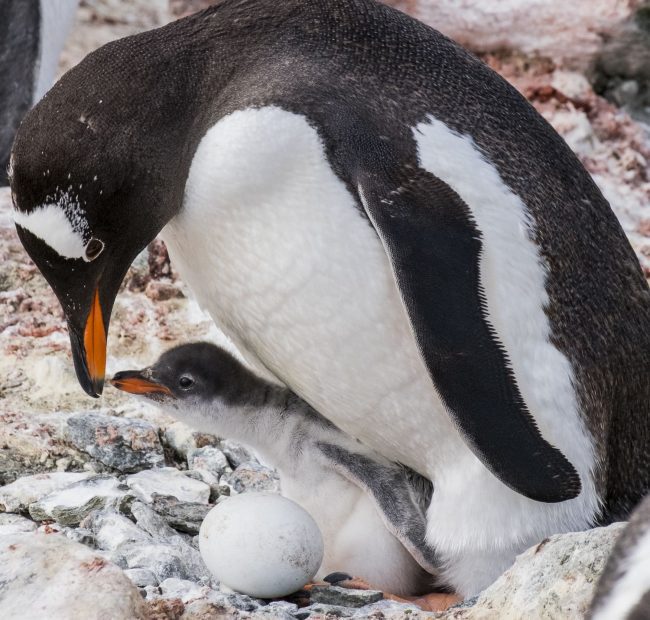

Everyone loves penguins, and there’s no doubt that they’re one of the main reasons people want to go to Antarctica. But even if you think you know everything there is to know about these adorable birds, you’ll be surprised by just how cute they are in person.
From the moment you see your first penguin waddling along the shore, you’ll be hooked. And when you see them swimming and playing in the water, you’ll be even more amazed.
But penguins aren’t the only animals you’ll see in Antarctica. You might also spot seals, whales, and a variety of other birds.
Although penguins are usually the star of the show in Antarctica, there are actually a variety of other animals that call this continent home. Seals are one of the most common, and you’re likely to see at least a few of them on your trip.
There are two main types of seals that you’ll see in Antarctica: fur seals and elephant seals. Fur seals are the smaller of the two, and they’re known for their thick brown fur. Elephant seals, on the other hand, can weigh up to four tons and they’re named for their long noses.
It’s difficult to beat the feeling of seeing a whale breach the surface of the water. And if you’re lucky, you might just get to see this amazing sight while you’re in Antarctica.
There are a variety of different whales that you might see, including humpback whales, blue whales, and orcas. Keep your eyes peeled, and you might also spot some dolphins or porpoises.


Cruise ships cannot take on fresh supplies of food while they’re in Antarctica, so everything onboard has to be carefully planned and rationed.
But even with these restrictions, the food on an Antarctic cruise can be surprisingly good. There will be a mix of buffet and sit-down meals, and you’ll have a chance to try some new and interesting dishes.
Of course, you’ll also have the opportunity to eat some of the fresh seafood that’s caught while you’re in Antarctica. Whether it’s grilled fish or lobster, you’re sure to enjoy it.
Travelers who have seen the icebergs in person always remark on how much bigger they are than they expected. And while it’s impossible to get an accurate sense of scale from photos, it’s still hard to believe just how big some of these icebergs really are.
In addition to their size, icebergs are also incredibly plentiful in Antarctica. You’ll see them floating in the water, and you might even get the chance to walk on one if it’s beached. Just be careful not to get too close to the edge.
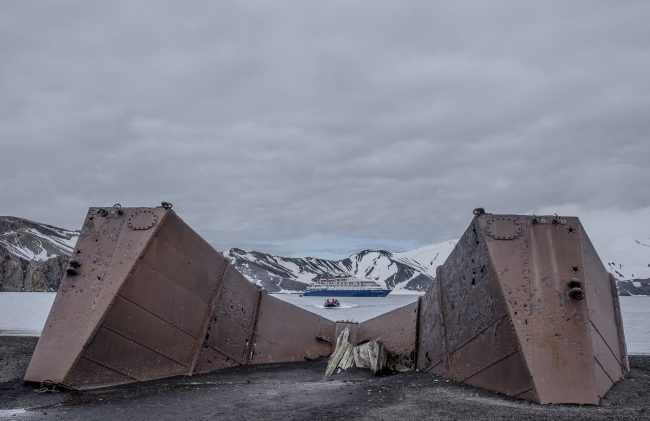

Many travelers going to Antarctica are surprised to learn that it’s actually home to a number of different islands. And while each island has its own unique features, there’s one in particular that stands out.
Deception Island is an active volcano, and it’s one of the only places in Antarctica where you can find warm soil. The heat from the volcano melts the snow, creating a small patch of land where plants can grow.
But that’s not all Deception Island is known for. It’s also home to a large colony of penguins, as well as the remains of whales that were stranded there long ago.
These are just some of the things you’ll see on an Antarctic cruise. So if you’re looking for an adventure, this is definitely the trip for you.
Many who travel to Antarctica come back with hundreds, if not thousands, of photos of penguins. And it’s easy to see why—they’re incredibly photogenic animals.
But what many people don’t realize is that penguins actually have a bit of an odor. It’s not too strong, but it’s definitely noticeable when you’re up close.
So if you’re thinking of getting a photo with a penguin colonies, be prepared for the smell. But it’s definitely worth it, because they’re such amazing creatures.
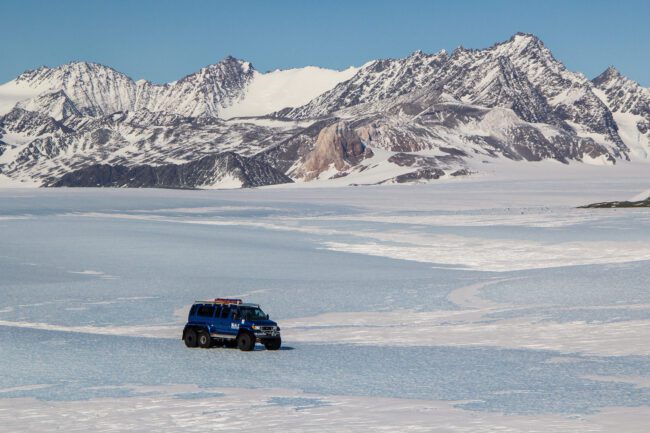

When you think of Antarctica, you probably picture an endless expanse of snow and ice. And for the most part, you would be right.
There are no roads or street cars in Antarctica—just snow and ice as far as the eye can see. This is one of the things that makes it such a unique and special place. If you venture to choice Antarctic camps you may have the opportunity to ride in an snow and ice-capable van!
Seasickness is the bane of most cruises, but you might be surprised to learn that it’s not a problem in Antarctica.
Because of the way the waves move in the Southern Ocean, most people don’t get seasick while they’re cruising. So if you’ve been worried about this, you can rest assured that you’ll be fine.
Of course, this doesn’t mean that everyone will be immune to seasickness. But it’s definitely less of a problem in Antarctica than it is in other parts of the world. If you are often affected by motion sickness, it is always best to come prepared just in case!
One of the best things about cruising in Antarctica is that you’ll have the opportunity to see some of the most amazing stars in the world.
Because there is no light pollution, the stars are incredibly bright and clear. You might even be able to see the Southern Cross, which is a constellation that’s only visible in the Southern Hemisphere.
Those who love wildlife, adventure, and natural beauty will find that Antarctica is the perfect destination. From the moment you set eyes on an iceberg to the time you see your first penguin, you’ll be amazed by this incredible place. So if you’re looking for a once-in-a-lifetime experience, an Antarctic cruise is definitely for you.
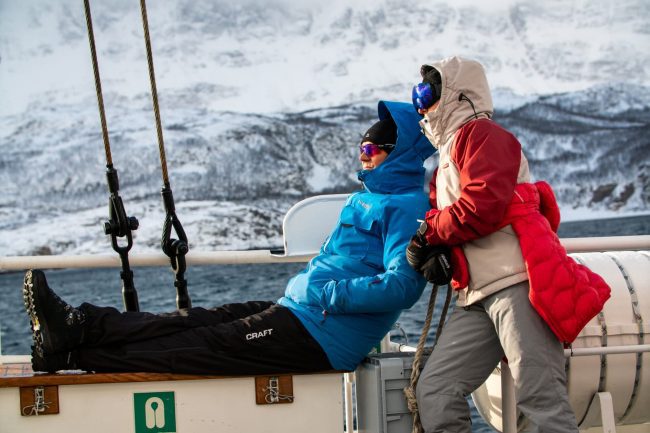

If you plan a cruise to Antarctica, you’ll find it is an experience you will never forget. It is a place of natural beauty and wonder, where you can see some of the most amazing wildlife on the planet. You’ll come away from your trip with memories that will last a lifetime. So what are you waiting for? Book your Antarctic cruise today!
So many folks ask us about the cabins on our ships. Let us just say, they are absolutely beautiful. Each one comes with its own private balcony, where you can enjoy the views of the Antarctic landscape.
Inside, the cabins are spacious and comfortable, with plenty of storage space for all your belongings. You’ll have everything you need to make your cruise a truly enjoyable experience.
There’s never a dull moment on our ships. In addition amazing excursions, we have plenty of on-board entertainment to keep you occupied.
There’s a movie theater, a casino, several bars and lounges, and even a dance club. And of course, there’s always plenty of live music to enjoy. You’ll never find yourself bored even when you aren’t out exploring.
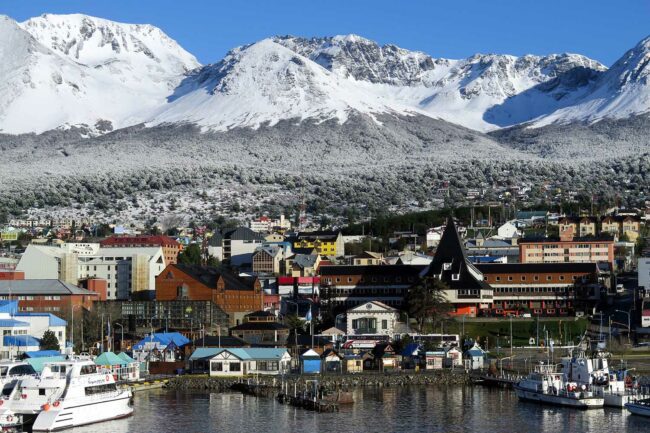

Each day in port is filled with exciting activities. We offer a variety of excursions, from wildlife watching to glacier hiking.
Or you can just explore towns on your own. There’s always something to do in port, and you’ll never find yourself bored or without options.
Even though there’s plenty to do on the ship, we also spend several days at sea during our cruise. This is when you can really sit back and relax.
You can take advantage of the ship’s many amenities, or just enjoy the stunning views from your private balcony. Either way, you’re sure to have a great time during your days at sea.
There are many different types of Antarctica cruises, from budget-friendly options to luxury expedition vessels. The most popular type of cruise is the small expedition ships, which carries around 100 passengers. These cruises offer a more intimate experience and allow you to get up close and personal with the wildlife and landscapes of Antarctic expedition. For those looking for a more luxurious experience, there are also cruises that offer larger ships with private balconies, spas, and five-star dining. No matter what type of cruise you choose, Antarctica is sure to be an unforgettable experience.
When packing for an Antarctica cruise, it is important to keep in mind that the weather can be unpredictable. Be sure to pack plenty of layers, including a warm coat, gloves, hats, and scarves. You will also need comfortable shoes for walking on ice and snow. Don’t forget to pack your sunscreen, as the sun can be strong even during the winter months. And finally, be sure to bring your camera to capture all the amazing sights of Antarctica.
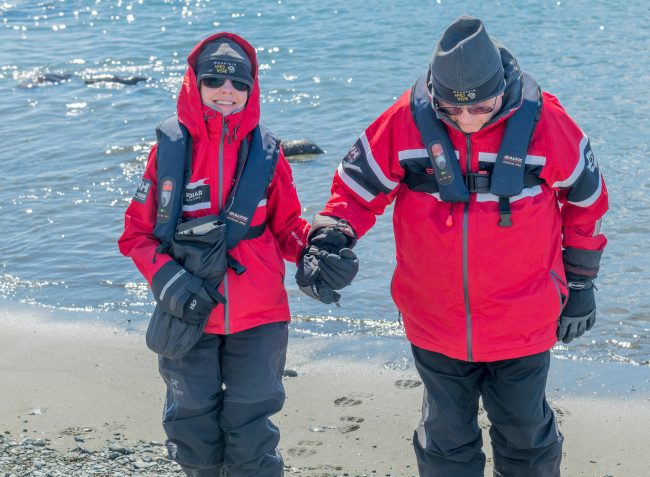

There are many benefits to taking an Antarctica cruise. For one, you will get to see some of the most amazing and unique wildlife in the world. You will also have the opportunity to explore the stunning landscapes of Antarctica, including glaciers, mountains, and icebergs. Cruises also offer educational lectures and activities led by experts, so you can learn more about the history and culture of Antarctica. And finally, cruises offer a once-in-a-lifetime opportunity to see the Southern Lights.
Yes, an Antarctica cruise is safe. The ships that operate in Antarctica are some of the most well-equipped and sturdy vessels in the world. They are designed to withstand the harsh conditions of the Antarctic expedition waters and have a crew of experienced professionals. In addition, all passengers must undergo a medical checkup before embarking on an Antarctica cruise.
Some of the most popular Antarctica cruise destinations include the Ross Sea, the Weddell Sea, and the Falkland Islands. These areas offer some of the best opportunities to see wildlife, including penguins, seals, and whales. You will also have a chance to explore glaciers, icebergs, and mountains.
We hope this overview of Antarctic cruises will inspired you to consider traveling to Antarctica for your next vacation! It truly is an unforgettable experience, and one that we would recommend to anyone with a desire for adventure! If you have any questions, or are interested in booking your own Antarctic adventure, please contact our team!
Many people know of Antarctica, but most do not realize you can travel to Antarctica with your friends, your family, or by yourself! This trip can be a reality on your bucket list and does not have to be just a dream. The biggest question is, can you travel to Antarctica? The answer is YES! Let me tell you how! There are numerous Antarctica tour packages to choose from, have a look or let us help you look at the options that are the best for you! Our phone number is listed on our home page, as well as at the bottom of every page.
Flying to Antarctica is possible, but it is less common and more expensive than standard cruise options.
There is only one company that flies directly to the south pole, and they charge about $93,000 USD per person. This is not a trip for the average traveler. It is more common to fly to South America or South Africa, and then catch a cruise to Antarctica. This is also more affordable for most travelers.
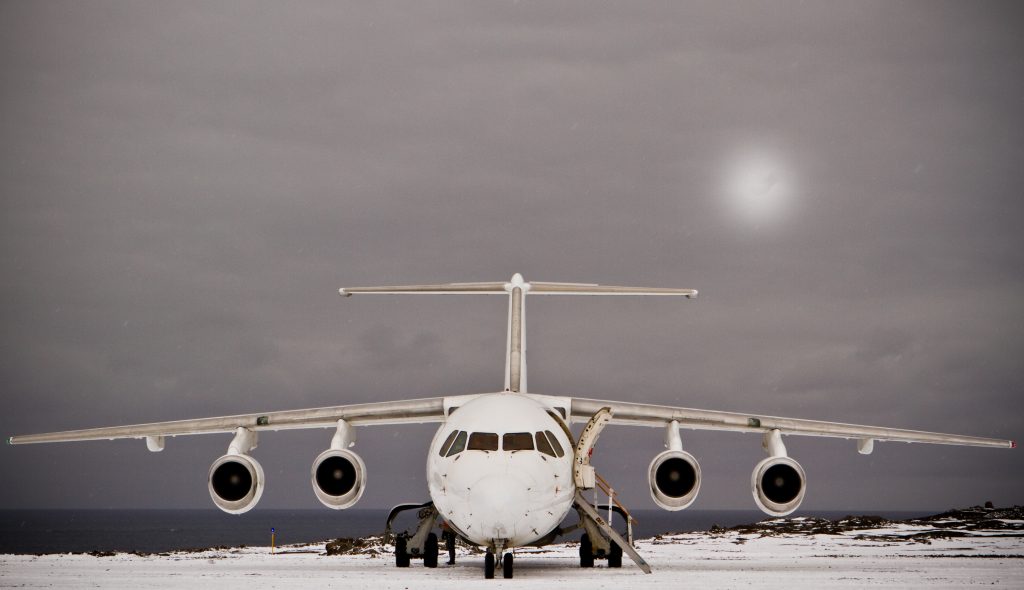

The most common way to travel to antarctica is to cruise from South America. Many Antarctica tour packages would start by flying into Buenos Aires (if traveling from the U.S. or Canada) and catching another flight to Ushuaia, Argentina. The reason you cannot travel straight there is because it is a smaller airport and not many airlines make direct flights from the U.S.
From Argentina you will get aboard a cruise ship, size will depend on tour package chosen and how much you want to spend on your Antarctica trip. The cruise to Antarctica you choose will strongly depend on your adventure level and budget. Some Cruises only cost about $5,500 USD and others can get up to $25,000 USD. There are many more antarctica cruise options to choose from than there are flights, and this is a main reason as to why it remains the most popular way to travel to Antarctica!
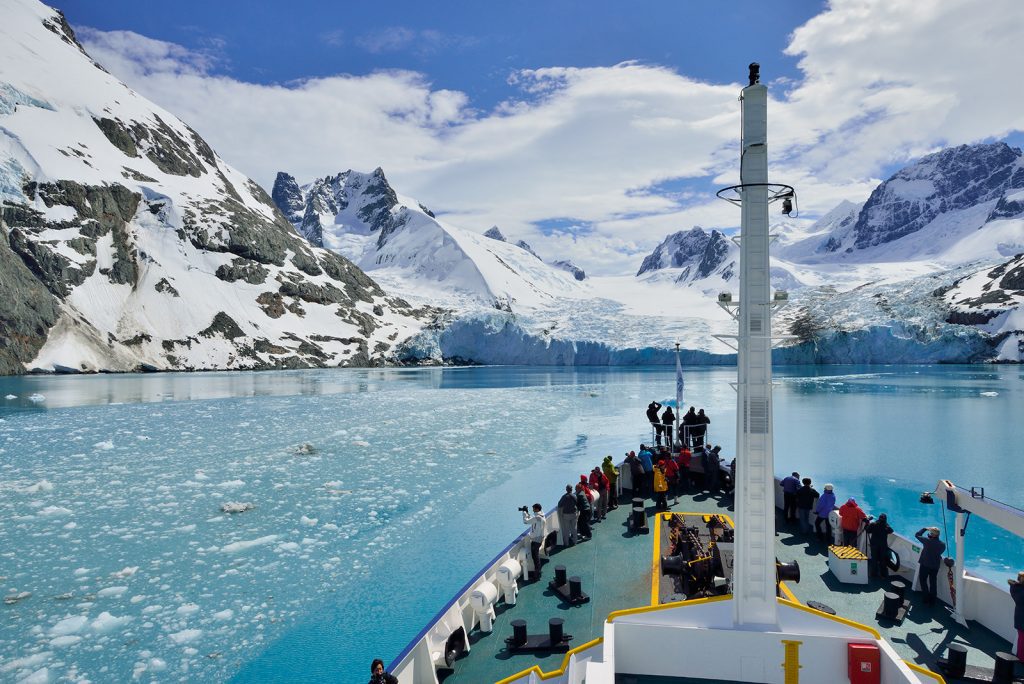

Once on the ship, it will take about two days at sea to reach the first portion of the Antarctic. This is when you will begin to see icebergs and ice caps, how you always envisioned. Although sailing to the south pole may seem time consuming and a lot of work, it remains the most adventurous way to travel. Encountering 40 foot swells while sailing there can make the trip that much more fun. Your travel guide will navigate you through the entire cruise, and make sure to provide you with any sight seeing during your time at sea! They make sure not to let you miss any important detail of your Antarctica trip, or get too bored at sea. Cruises also have experts aboard who give many talks about local wildlife, geology, and history! There is plenty to see and do aboard your cruise ship while you wait to reach the snowy banks of the continent.
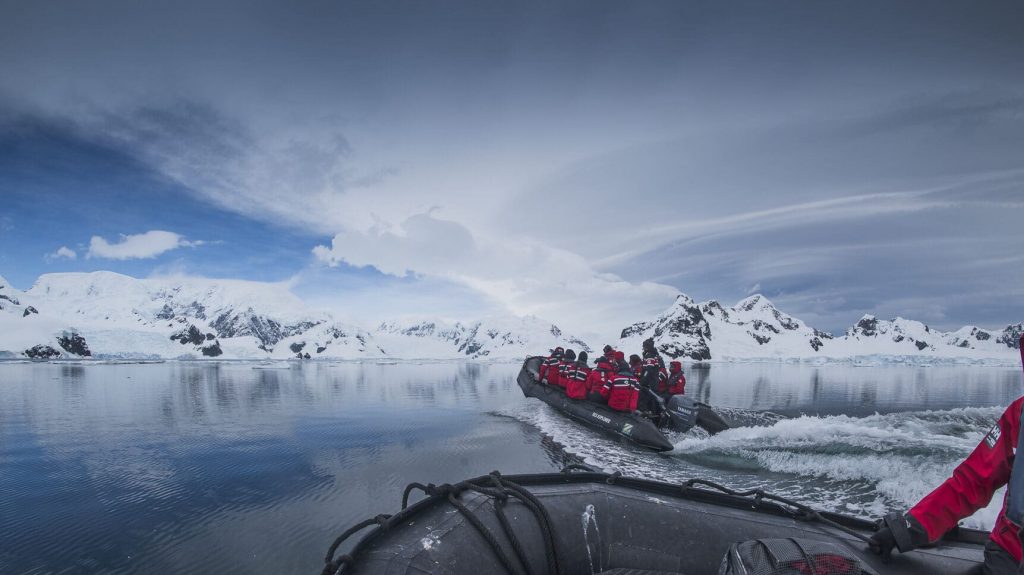

If you have any questions about how you can travel to Antarctica, please contact us and use our team as a resource! The Polar Holidays team has a decade of polar travel experience, especially to and from Antarctica, and would love to assist you in planning your trip. We are happy to speak over the phone with you, or you can send us an inquiry and we will get back to you as soon as possible. Happy traveling!
If you are wondering when you should go to Antarctica, it depends on what your intentions are for the trip. If you are going on vacation to simply explore the wildlife and scenery, you should go in the summer. If you are going to research, you will likely be there year-round and will experience the most extreme climate on planet Earth. Either way, you should know what it will be like when you go to help you prepare both physically and mentally for the world of the Antarctic. Our goal is to help you decide when you should book your trip, and what you will be getting yourself into depending on which month you visit!
Because of its location at the South Pole, Antarctica only has two seasons: Summer and Winter. Summer is the season during which cruises and excursions take place while winter is the harshest climate on Earth and only researchers are there during this time because the conditions are too harsh for flights or cruises.
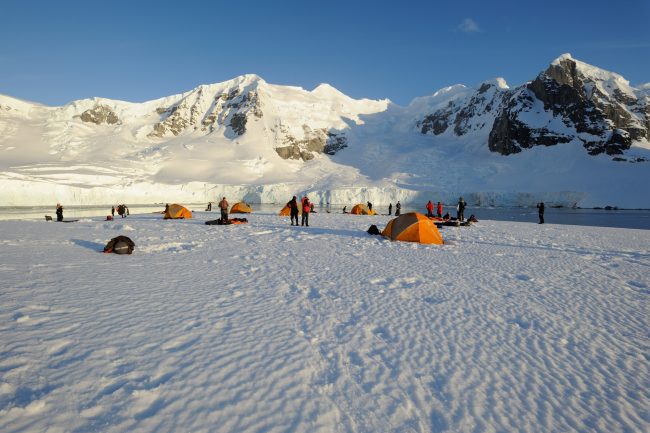

If you choose to go to Antarctica during October, you will be one of the first visitors of the season!
Weather:
This will be the coldest time to take your cruise trip. Temperatures on the coast average 5 F (highest) and -10 F (lowest). Please keep in mind these are temperatures on the coast and further inland you go, the colder it will be. Daylight in October averages 14-17 hours, increasing to 18-20 hours in November.
What you will see:
October through November is the absolute best time to go if iceberg scenery is important to you. It is the best time to see Antarctica’s fresh snow and clear ice carry over from the wintertime. In South Georgia, the mountaintops are still capped with snow allowing for amazing photography opportunities. This is also the best time to go if you want to see breeding elephant seals!
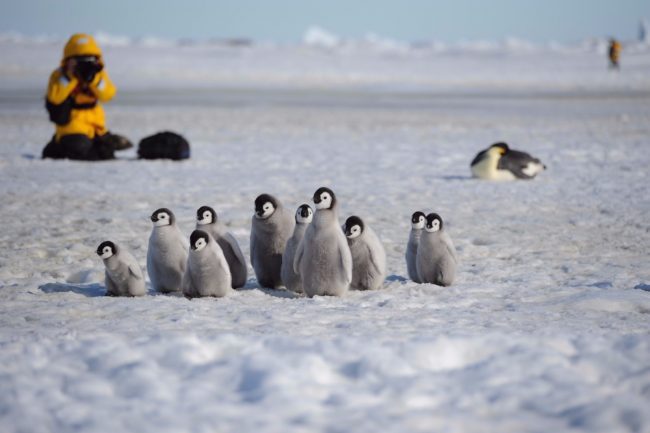

Weather:
These two months are the most popular times to travel to Antarctica as it is they are the warmest months. Daylight lasts 24 hours, temperatures start rising in December and in January they can break 32 F or higher in some areas.
What you will see:
Penguin chicks have just hatched! You will be able to get off the ship and get up close to these little guys in the Antarctic Peninsula. During this time, the parents go out to search for food so the penguin chicks huddle together until their parents return. Watch closely and you may get to see the little babies running to reunite with their parents. This is also the time of the year in which newborn seal pups can be seen out on the Falkland Islands and South Georgia. January is also the first opportunity at accessing the Ross Sea. You will be able to start seeing whales, another reason people love going during this time because you get a wide variety of experiences.
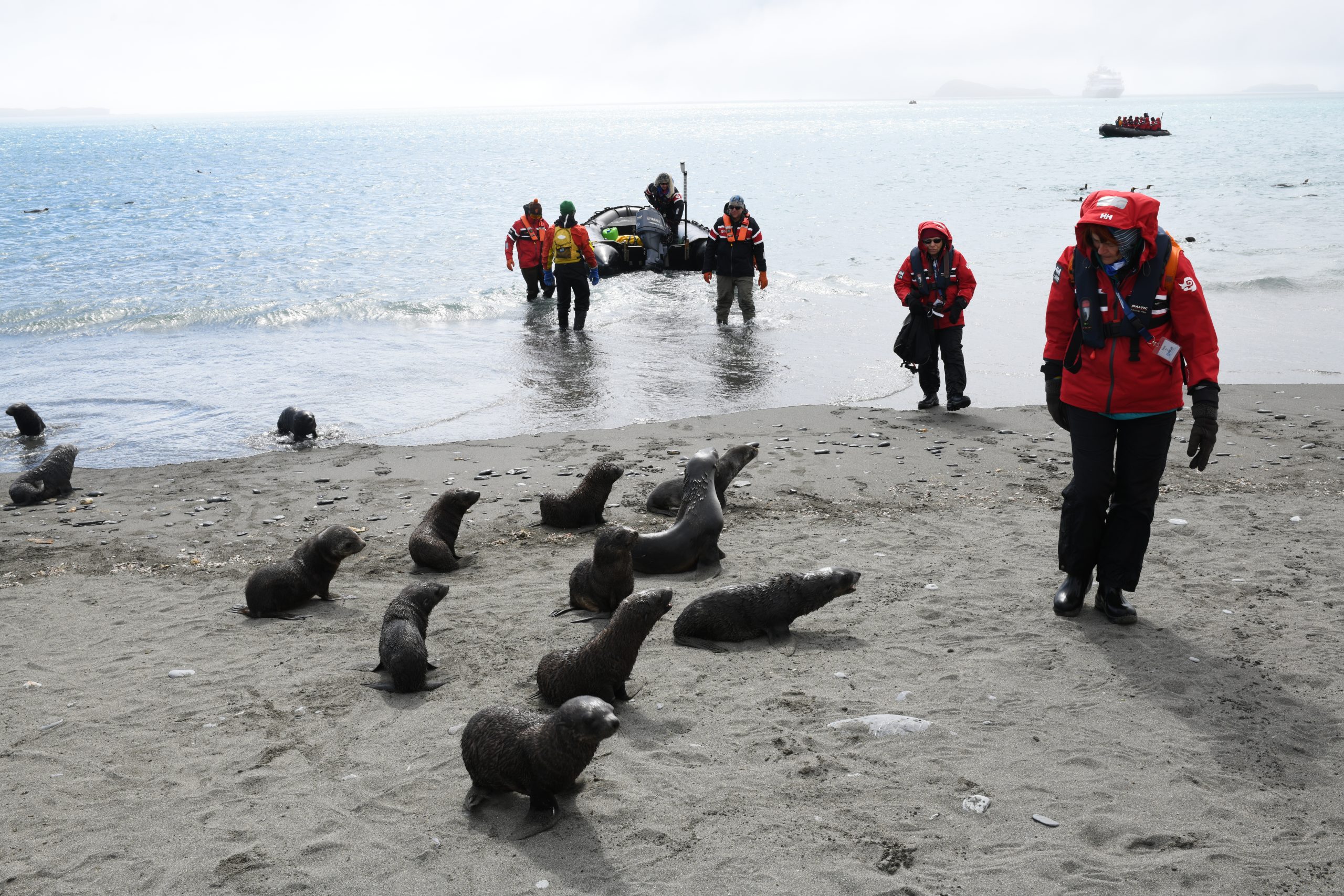

February is considered the last month of “high summer” in Antarctica meaning prices are at a premium when compared to March which usually has lower prices.
Weather:
Since this is late summertime in Antarctica, the average temperatures are still warm in February, but begin dropping in March. In February, the average temperatures are 34 F in the Antarctic Peninsula, 45 F in South Georgia, and 46 F in the Falklands.
What you will see:
If seeing wildlife is at the top of your to-do list during your trip, February is the time to go. During the most active wildlife month, you will get to see penguin chicks begin to develop wing feathers that are large enough for flight, meaning you will see them take their first attempt at swimming. You will also get to see their parents go diving for food for their babies, meaning leopard seals are out searching for prey. February and March are also the best times to see many whales including humpback, minke, and orca. If going to South Georgia during this time, you will see king penguins start laying their eggs which means you will also see the most birds here.
As the sun is out almost 24 hours a day, it melts some of the ice sheets allowing access to the Ross Sea which you may not get during any other time of the year. This is also the best time for Antarctic Circle crossing.
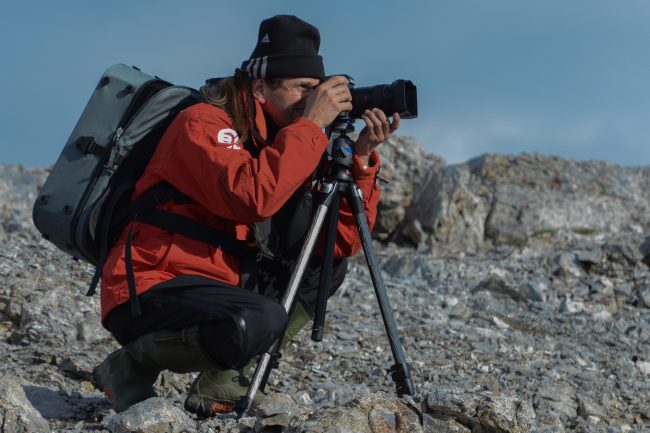

During the winter, there is 24 hours of darkness. After the last ship leaves and the last flight takes off back to South America, anyone who is still in Antarctica is not leaving until October/November. If you do decide to stay in Antarctica during this time, please make sure you are mentally prepared as depression is a common side effect of the darkness as there is a Vitamin D deficiency.
Weather:
Early July is the heart of winter in Antarctica and temperatures actually get below -100 F, 50 degrees past the temperature at which gasoline freezes. Some researchers join the 300 Club by heating themselves in a 200 degree sauna and then running out into the -100 degrees Antarctic air. In 1983, the coldest temperature ever was recorded in Vostok (-89.6 C or -129.28 F). if you take into consideration the high altitude levels averaging 6600-8000 ft (the average for other continents is 2300-2600 ft), the conditions become much worse than you originally thought.
What you will see:
There are 3 U.S. research stations in Antarctica: the Amundsen-Scott South Pole Station, McMurdo Station on Ross Island, and Palmer Station on Anvers Island. In April, you will see gradual darkening of the sky so every day you will see more stars than you did the day before. If you are an astronomer, this would be exposure you would never get anywhere else! The moon during this time is out 24/7 so some say you can even see it change phases.
Interested in Antarctic travel, or want more information about Antarctica? Reach out to our team! We’d love to speak with you and answer any questions you may have, or assist you with booking your Antarctica cruise!
A solo trip to Antarctica can be one of life’s most fascinating and memorable experiences. The frozen continent remains one of the world’s underexplored frontiers, with so much to experience. Still, only a small fraction of people will ever see and explore it.
The sublime, wind-scarred ice sheets, the abundant marine life, and the stark contrasts between the dark, cold ocean and the blinding white snow. These, as well as remnants left by the early explorers like Ernest Shackleton, are unforgettable.
Antarctica is not often the first place people think of when researching destinations for their vacation. However, as one of the most unique continents on earth, a cruise to Antarctica provides an experience unlike any other.
Antarctica is one of the continents that remains mostly untouched in its natural beauty. Tourism is increasing, but still on a very small scale, and most of it doesn’t interfere with the stunning scenery and wildlife. If you are wondering how big Antarctica is, with a surface area of 14 million square kilometres, it is massive. You’ll see the stars more brilliantly than ever due to the lack of light pollution. Below the skyline travellers will see beautiful icebergs, as well as seals and penguins of many species.
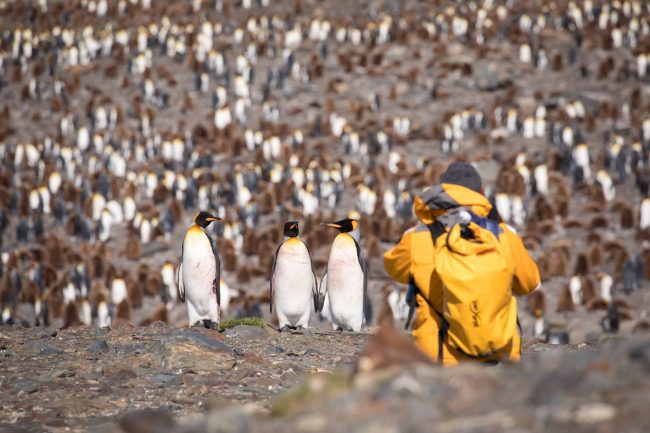

Only a small number of people are permitted to disembark in each area, and only for a few hours each day. You are unlikely to see people from other cruise ships, and will spend time viewing the continent from your cruise ship, as well as exploring on land.
Some of the best things to do as a solo traveller include:
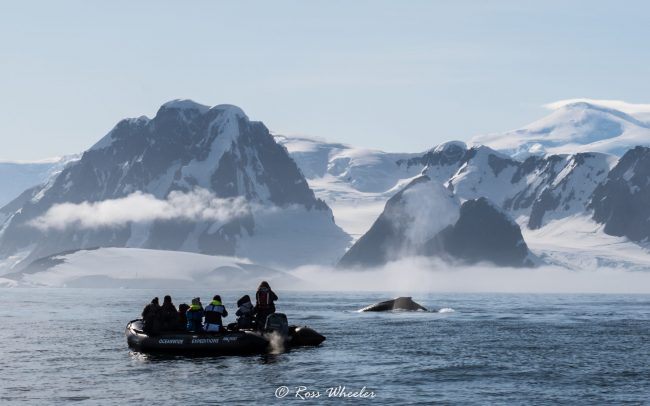

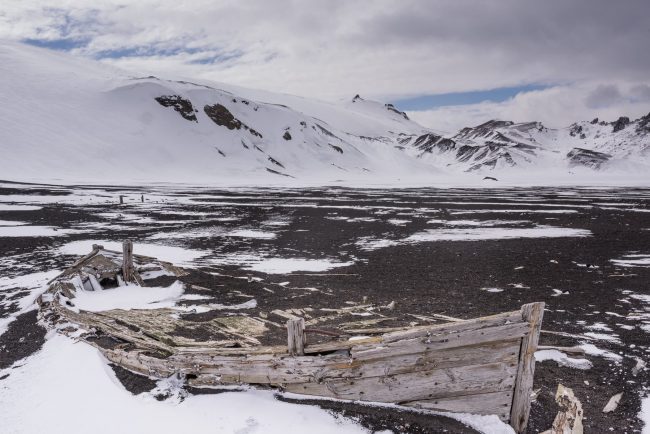

Travelling alone on an Antarctica cruise can sound like an overwhelming experience. However, if you do choose to travel to Antarctica solo, you’ll be pleased to know arrangements are in place. You can either be matched with someone for no additional cost and share a cabin, or you can pay a single’s supplement. The reason for charging a single’s supplement is due to the need for a private cabin being more costly than finding one for a couple.
Many of the activities available when you arrive are done as groups, so there will be plenty of people to meet and spend time with. There is camping, kayaking, swimming (the polar plunge), and even cross-country skiing.
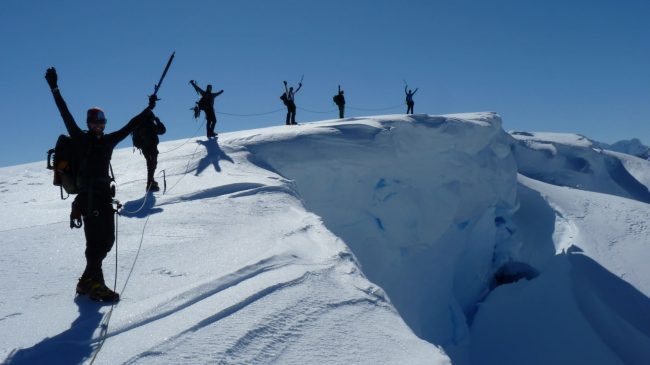

If you choose a cruise, you will also have plenty of opportunities to meet other like-minded travellers who are just as interested in the continent of Antarctica as you are. There’s a good chance you will not be the only solo traveller on board. That just means even more opportunity to meet individuals in similar circumstances.
Finally, most cruise ships have an open seating policy at dinner – you can move around and converse with others as you like. It makes for a truly friendly atmosphere with everyone chatting and mingling.
Traveling solo in Antarctica is going to be one of the most exhilarating experiences – you will make new friends and see the pristine regions of Antarctica together.
What is important is that you come prepared. Do your research and choose the cruise or air travel plans that best suit the kind of experience you are looking for. An Antarctica flight can be expensive, so watch out for the best deals for solo travellers.
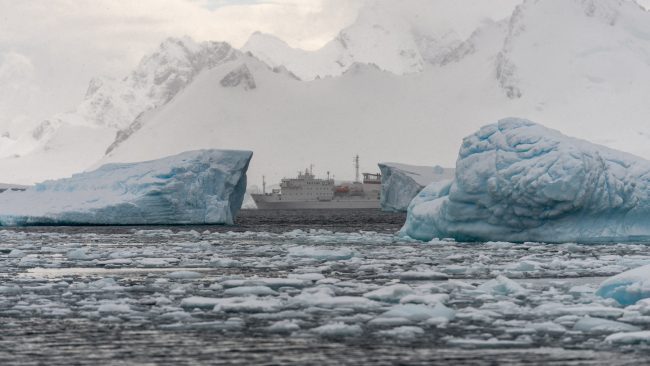

The type of Antarctica cruise ship you choose can play a considerable role in the type of travel experience you end up with.
Luxury ships are bigger and have a much wider range of facilities and activities. However, they are also more costly and are not as focused on one type of activity. They also provide fewer activity adventures such as camping on Antarctica. Smaller ships will allow you more time on land. Therefore, you might want to consider something smaller for a more personal experience with the Antarctic.
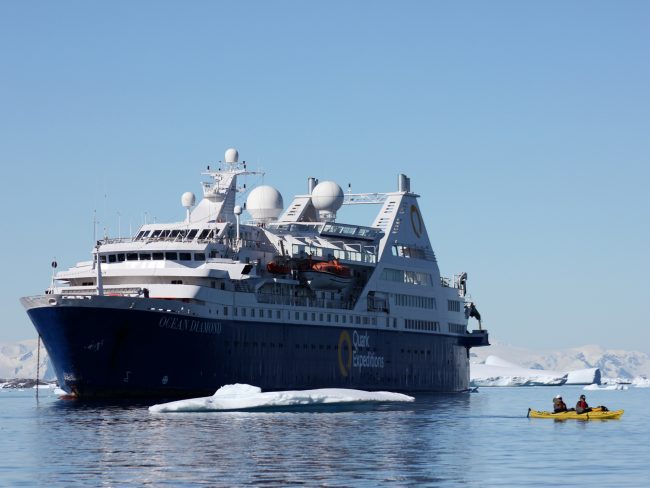

The Ocean Diamond can hold up to 189 passengers
As a solo traveller, you can often opt to try for an expedition ship as well. These tend to hold only 50-100 passengers, allowing a more tight-knit experience. These expedition ships still have showers in the rooms, a small library and other amenities to make your Antarctica cruise comfortable.
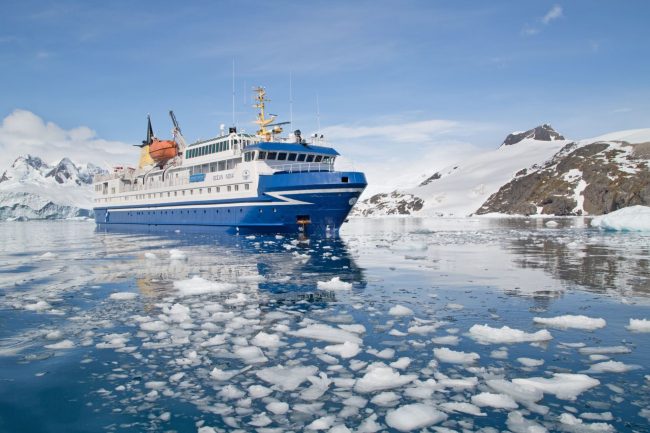

The Ocean Nova can hold up to 67 passengers